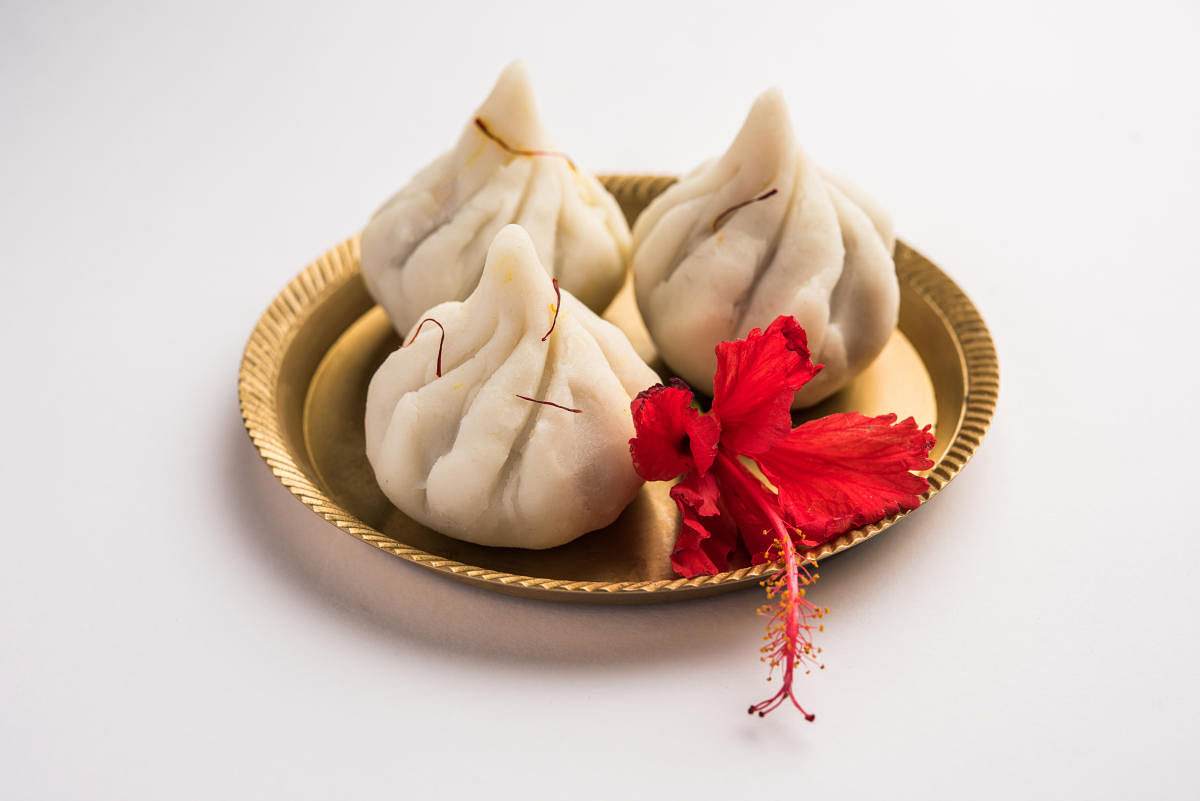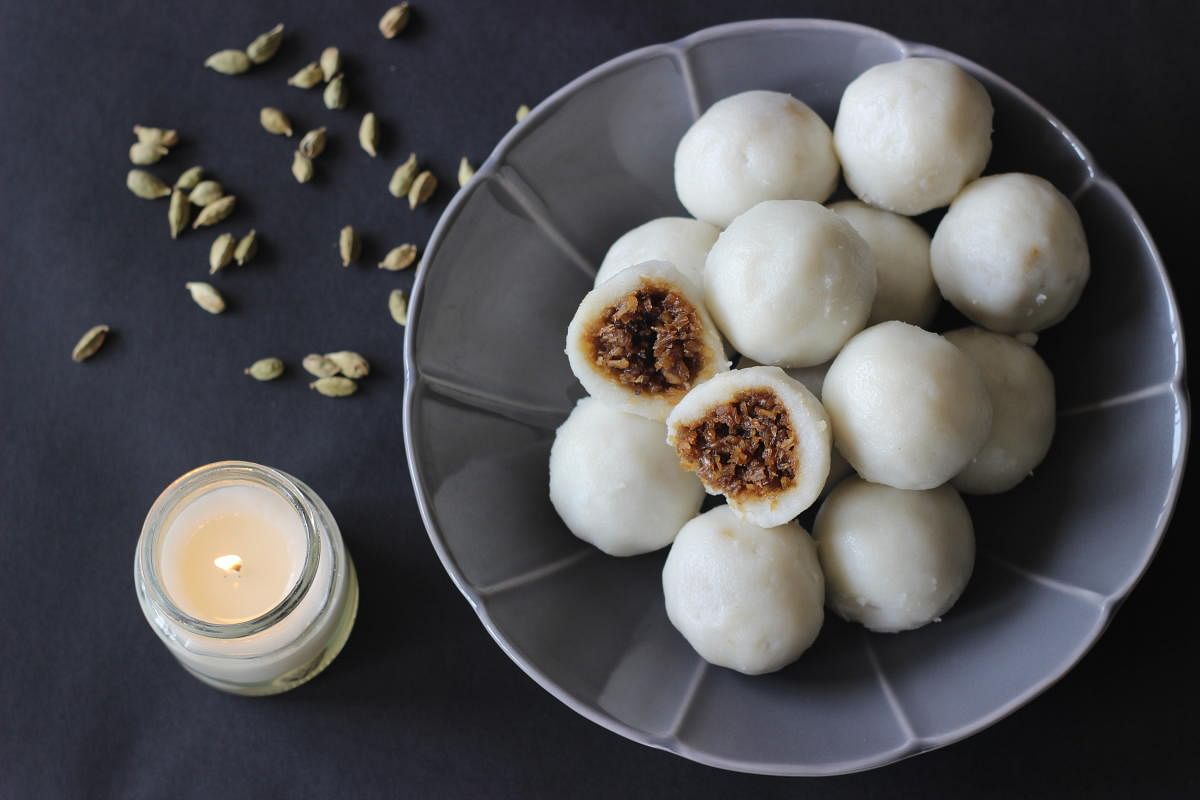

In appearance, this quintessential Maharashtrian speciality resembles a dumpling, or more accurately, kangiten, the fried buns offered to Lord Ganesha or Kangiten in Japan. In popularity, the modak easily rivals laddoos, especially around Ganesh Chaturthi, a festival it has become synonymous with. In ancestry, it finds a mention not only in the Vedas but also in the Samhitas.
One of the oldest mentions of the modak is found in the Charak Samhita, where two variants by the name Abhayadi Modak and Shatavari Modak were used to administer the right dosage for curing any illness and balancing the doshas as well. While many culinary anthropologists, including seasoned culinary revivalist Chef Sabyasachi Gorai, believe the earlier variants may have inspired the shape and
composition of the ukdiche modak — after all, rice-based, coconut jaggery filled steamed treats were used widely as antidotes for quite a few illnesses since the Indus Valley Civilisation — there is little information as to when and how the modak became such a celebrated treat and a must-have during the 10-day festival.
While mythological stories place the modak as Lord Ganesha’s favourite, both as a reward given to him for his intelligence by Goddess Parvati and a satiating treat served by Sage Atri’s wife Anusuya that led to Lord Shiva burping 21 times thus starting a tradition of offering 21 modaks; historical mentions pin the association around the early Sangam period when Lord Ganesha rose to prominence as family deities of kings had dedicated temples to them. Or as Chef Gorai puts it, to a time when Lord Ganesha attained the name Vignaharta or the God who takes away all problems and issues. The Madhur Mahaganapathi Temple in Kerala where appams are offered to the lord annually is one such example. Once in every 160 years, his idol here is covered with a mixture of sweet rice and ghee called Moodappam
The making of the modak
Those who have tasted the appam equate it to ukdiche modak, which eventually became the designated prasad for pleasing Lord Ganesha. But how did the transformation from appam to modak take place? One school of thought credits the making of the modak to the priest who would often chant mantras before giving the prasad to the devotees and would inadvertently create something that looked like the modak; Chef Gorai however, finds a Vedic connection to the same. Most prasad, adds Chef Gorai, “in our culture has effectively played the twin role of the taste and healing. And their association with a particular festival or celebration is often based on two factors: one, seasonal availability and two, the need to have that kind of sweet during the time for good health. Modaks, which are an innovation of traditional appams are no different. Concurs seasoned chef and Maharashtrian food specialist Mandar Madhav, whose best association with the 10-day festival is the steamed ukdiche modak, who he believes is the original form that was offered by Shivaji Maharaj who transformed the till then home-bound Ganesh Chaturthi festival into a court celebration aimed at building a sense of one community, one nation among his subjects. And one way he did so was with modak.” While simple in its making, the use of local ingredients that were available in abundance worked wonders to bring his kingdom together, religion, faith notwithstanding.
After all, adds Chef Madhav, “here was a sweet that could be made in large quantities because Ganesh Chaturthi is the time when coconuts are ripened to be eaten and offered and of course there’s an abundance of rice too. And since modak making was simple, it could be made in large quantities and distributed generously.” What gave this simple rice-based dumpling with coconut, jaggery its remarkable ability to pander to a wide palate, adds culinary researcher and chef Viveq Pawar, “was the sheer composition of fat, sweet and a bit of sodium thanks to the use of coconut and jaggery, and steaming.
A healthy dumpling
For making ukdiche modak, the rice powder is cooked into a dough after which it is turned into these little purses with a sweet filling which is again steamed. While the steaming gives it the lightness and easy digestibility making it safe for people of all ages, it also lends the modak its low glycemic index.
This means, adds Chef Pawar, “that a single piece of modak would often give you the feeling of satiation given the time period it needs to digest. In addition, the sweet filling and saturated fat in it helps the medium-chain triglycerides that protect the heart and keep blood pressure levels in check while also balancing the circadian rhythm of the body to give that sense of bliss.”
In fact, the blend of ghee in rice ensures that there is enough mucus formation to enable effective digestion and the elimination of toxin residue in the body while giving enough energy to the brain to calm down. Mucus is extremely important in the gastrointestinal tract as it forms an essential layer in the colon and in the small intestine that helps reduce intestinal inflammation.
Nutrition-wise, this is a process that often translates as “satiation’ not just of the stomach but mind and soul as well.
Such was the effect of the taste and healing of modak along with its association with Lord Ganesha, that Ganesh Chaturthi attained the tag of a national festival thanks to Lokmanya Tilak.
One now finds many versions of the modak across India — while Odisha has the Monda Pitha, there is Kozhukattai in Tamil Nadu, Karjikai in Karnataka and modak in Gujarat.